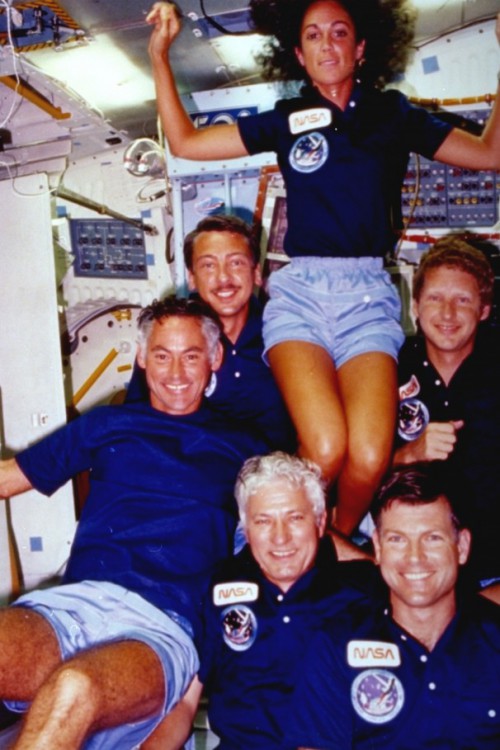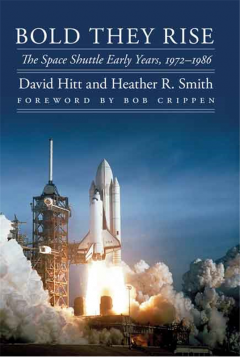
Heywood Floyd: …What? What’s going to happen?
Dave Bowman: Something wonderful. — 2010: The Year We Make Contact, 1984
It would be easy to characterize Bold They Rise: The Space Shuttle Early Years, 1972–1986 as the shuttle program’s equivalent of co-author David Hitt’s Homesteading Space Skylab volume (from the University of Nebraska Press’ Outward Odyssey series, which this book is also part of). One might also expect it to be merely a chronological history. However, readers can ditch their expectations at the door and get ready for some surprises.
Bold They Rise is the early STS-era companion to other books in the series, including Francis French and Colin Burgess’ In the Shadow of the Moon and Rick Houston’s recently published Wheels Stop: The Tragedies and Triumphs of the Space Shuttle Program, 1986–2011. Bold They Rise finds the “Golden Era” of the shuttle days chronicled in loving detail—similar to those volumes which respectively discuss the beginnings of the race to the Moon and the later shuttle years—while showcasing the disparate, unexpected personalities involved in the development and genesis of the space shuttle, which went from being a blueprint on a page to an American icon.

The book begins with a foreword from the shuttle’s first pilot, Bob Crippen, who helped usher in the era with his STS-1 flight in April 1981. Over the course of the book, several vibrant personalities jump out of the pages. The most notable one is astronaut Thomas K. Mattingly, who was heavily involved in shuttle development years before its debut flight (and his own flight, STS-4, which launched in mid-1982). His stories are a delight to read, as he has not been the most “public” of Apollo/shuttle astronauts.
Other spaceflight figures who may not be household names (but deserve recognition) finally get their moment in the spotlight, including astronauts Vance Brand, Henry Hartsfield, and Gordon Fullerton, who passed away in 2013. Space enthusiasts—and amateur space historians just discovering the intricacies of the shuttle program—will enjoy hearing stories from these astronauts who contributed so much of their time and expertise during this era.
As the U.S. space program shifted its focus to deploying payloads and pursuing space science, it was clear a new breed of astronauts and space travelers were needed to accomplish these aims. The book addresses the genesis of mission specialists and the Spacelab program, an ESA/NASA collaboration. The book also underscores the contributions of non-career astronauts during the early shuttle days, dedicating a portion to payload specialists, who were ushered in by Charlie Walker (who ended up making three shuttle flights).
As Bold They Rise progresses, it becomes terrifyingly apparent that the objectives during that era involved an extremely high level of risk (not least, including the launches). The book underlines the proposed shuttle-Centaur “Death Star” STS-61F mission that never took place, as well as the planned 1986 “Polar Express” STS-62A mission, intended to launch from Vandenberg Air Force Base. For true shuttle aficionados, it’s fascinating to hear about the future that didn’t happen. Sadly, the future would grind to a halt, stopped abruptly by tragedy: the January 1986 Challenger disaster.
The words in Jane’s Spaceflight Directory 1986 (published that year, but largely written in 1985) were chillingly prophetic: “The narrow safety margins and near disasters during the [shuttle] launch phase are nearly forgotten, save by those responsible for averting actual disaster.” Disaster did happen, and the tragedy (and resulting resonances) would lead to the program canceling some of its riskier goals (such as STS-61F) and strengthening its resolve for safety.
Winston Churchill once said: “Now this is not the end. It is not even the beginning of the end. But it is, perhaps, the end of the beginning.” Bold They Rise chronicles the shuttle’s epic early successes and the “end of the beginning,” when adversity and hardship led to a whole new era of exploration, resulting in the International Space Station being built and the deployment of indispensable payloads. This book is essential reading and perhaps the perfect companion to Kennedy Space Center Visitor Complex’s recently opened Atlantis exhibit.
The opinions presented in this article belong solely to the author and do not necessarily represent those of AmericaSpace.
Want to keep up-to-date with all things space? Be sure to “Like” AmericaSpace on Facebook and follow us on Twitter: @AmericaSpace



